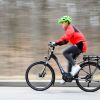Cycling boom
Cycling is very popular, especially in the German cities. It’s not only healthier, environment-friendlier and cheaper, it’s usually also quicker.

Markus Lewe cycles to work. Every day, whatever the weather. This is nothing special in itself; many people do it these days in Germany. But Markus Lewe is a mayor. He has to represent his city and has lots of official engagements during the day. But that’s not a problem either, because Markus Lewe is the mayor of Münster, the cycling capital of Germany. It has 300,000 inhabitants – but twice as many bicycles as citizens. Markus Lewe owns four of them: a racing bike, a folding bike, a Dutch bike and a touring bike. He also uses his bicycle when he’s on official business because it’s simply more practical. Münster is not too big, not too hilly, and the infrastructure for cyclists in the Westphalian university town is better than in most other German cities: cyclists have the car-free ring road around the city centre to themselves; you can get into the centre really quickly; and the bike station at the main railway station, the biggest in Germany, offers 3,500 secure parking spaces and includes a repair service, bike rentals and a bike-cleaning facility. “These days, 39 percent of trips in Münster are done by bicycle,” says Lewe proudly, “only 33 percent by car.”
Münster is a trendsetter in a development that can be observed all over Germany at present. People are switching from car to bike. It’s not only healthier, environment-friendlier and cheaper, it’s often also quicker. Because particularly in the cities it’s easier to get from A to B on a bike. According to the Federal Government’s latest nationwide survey on cycling (Fahrrad-Monitor 2013), 35 percent of those asked already cycle to work or college, and even more people use their bikes for shopping and short errands. The bigger the city, the fewer people use a car, says Fahrrad-Monitor. This is especially true of Berlin, where more people than average leave their cars at home and travel by public transport and bike. Members of the Bundestag (parliament) like Hans-Christian Ströbele also cycle from their homes to the nearby government district. In Frankfurt, bankers and consultants bike it along the Main river to the financial district. And in Cologne, even the Archbishop, Rainer Maria Woelki, can be seen on a bicycle from time to time – “if I don’t need to wear my cassock.” The example of Münster is also having an impact internationally. Representatives from London and New York have been to Westphalia to find out how a “bicycle town” works – because they are facing total gridlock, not only in their major cities. And the director of the Tour de France, Christian Prudhomme, has been to Münster for a different reason: he is considering using Münster as the location for a stage – or even the start – of the world’s most famous cycle race.
However, the bicycle is not only a modern alternative for urban mobility, it’s also an expression of a new lifestyle and a change in the way people think about status. Bicycles are seen more and more often in people’s homes instead of in a parking lot – as a decorative accessory. Students will have a fixie (a simplified version of a racing bike with only one gear), while managers might prefer a stylish bamboo bike. This often says more about the owner than the décor. The bulk of bicycles sold in Germany are still city, mountain or trekking bikes, but there’s no limit to what individuality can come up with. German has numerous small firms that custom-make bicycles by hand, and the German market offers everything from €20 second-hand bikes to discounter cycles and high-tech bikes with smartphone control. Electric bikes – with a small electric motor to support the cyclist – have been developing fastest of all: in 2009 they accounted for four percent of the bicycles sold in Germany; in 2014 one in ten new bikes sold were electric. Furthermore, 27 percent of the respondents would choose a bike supported by an electric motor if they were to buy a new bike now, says Fahrrad-Monitor. The electric bike is losing its old-fogey image: creative people have also discovered it in the meantime, press photographers use it to get to the scene faster, and bicycle couriers are switching too.
The cycling boom is encouraging the development of a new infrastructure. Very much part of the current trend are repair cafés, a mixture of self-help workshop and bistro. This is where all kinds of items that would otherwise be thrown away can be repaired and re-used. Making a high-quality bike out of used parts is regarded as a particular challenge. The idea originated in the Netherlands and has since been picked up by many people in Germany, where there were well over 100 repair cafés in 2014. ▪

